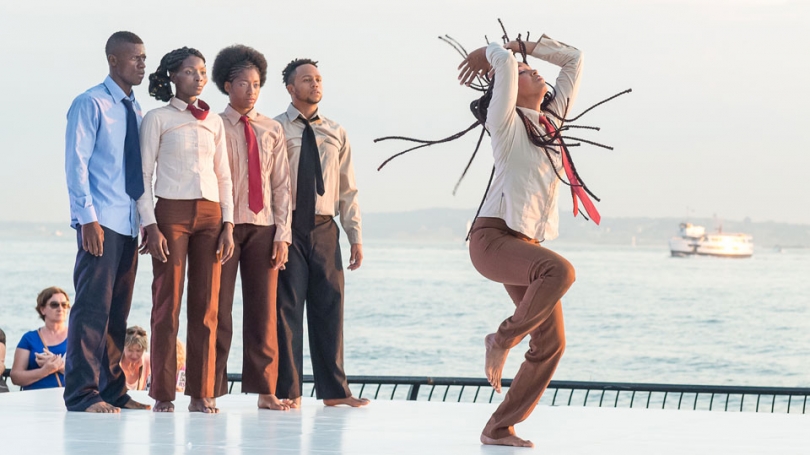The dreams and struggles of young Afro-Colombians, told through dance theater
September 17, 2019—A vibrant new work of dance theater reaches deep into the urban experiences of black Colombians, who remain a marginalized population in the country their ancestors first came to 500 years ago.
The City of Others, by Sankofa Danzafro, will be performed Thursday and Friday, September 26 and 27, at 7:30 pm, in The Moore Theater of the Hopkins Center for the Arts at Dartmouth College. In addition are two free events with the artists on Thursday, September 26: a conversation with Sankofa Danzafro director/choreographer Rafael Palacios at 6:30 pm and a dance party following the performance, which will also include members of Mashrou' Leila, who perform at the Hop Saturday, September 28.
Through movement vignettes danced by an electric young ensemble accompanied by live percussion, The City of Others unpacks the racial undercurrents of Colombia, a country home to Latin America's second largest population of people of African descent. The vignettes themselves were created from the dancers' own experiences growing up black in Colombia.
African slaves were first brought to the shores of what is now Colombia in 1520. Over those five centuries, they and their descendants built the country's wealth through backbreaking work in mines, plantations and factories; made up the majority of soldiers who fought for independence from Spain; and were disproportionately harmed in the civil war that wracked Colombia from 1964 to 2016, driving Afro-Colombians from their rural homelands into the coastal cities. Yet they still have far less access to the country's education and economic opportunities and are more often the victims of violence.
The dreams, tensions and resistance of these urban Afro-Colombians come through in dance that draws from capoeira, contemporary dance, hip-hop and African forms. The dozen dancers dressed in "office casual" or white, button-down shirts and brown pants as they reel around and ricochet off the desk chairs and plywood sheets that are used to depict office cubicles, commuter trains and prison cells that the show takes us to. The New York Times called the show "exhilarating … [a] forward-looking use of tradition …[that] evokes an urban environment where resilience meets harsh realities" (New York Times). Wrote the Boston Globe, "The City of Others" has enough kinetic energy to light up all of Boston. It's nonstop action — but that doesn't mean it doesn't leave room for thought."
Founded by Afro-Colombian Rafael Palacios in 1997 in the Pacific coast city of Medellín, Sankofa Danzafro is devoted to telling the stories of black Colombians, most of whom are descendants of West African slaves brought to Colombia to transform its lush natural resources into staggering generational wealth for Europeans. Wealth and opportunity continues to be highly racialized in Colombia, a status quo that Sankofa Danzafro's work eloquently addresses.
Taking its name from "sankofa," a Ghanaian word meaning "to return to the root," the company's mission "is to question the overall knowledge [and] to build a voice of self-awareness, which will allow us to reveal the epistimologies of the African diaspora in the world," Palacios told Boston's Fjord Review. "The City of Others is based on my own experiences and the dancers' experiences with regard to racism in Colombia and the struggles to resist and therefore debilitate it."
Tickets to The City of Others can be purchased separately or as part of a package, "Take a Hard Look," focusing on "social commentary embedded in performance … Compelling sounds, sights and story bring you face to face with realities you might otherwise not have examined."
